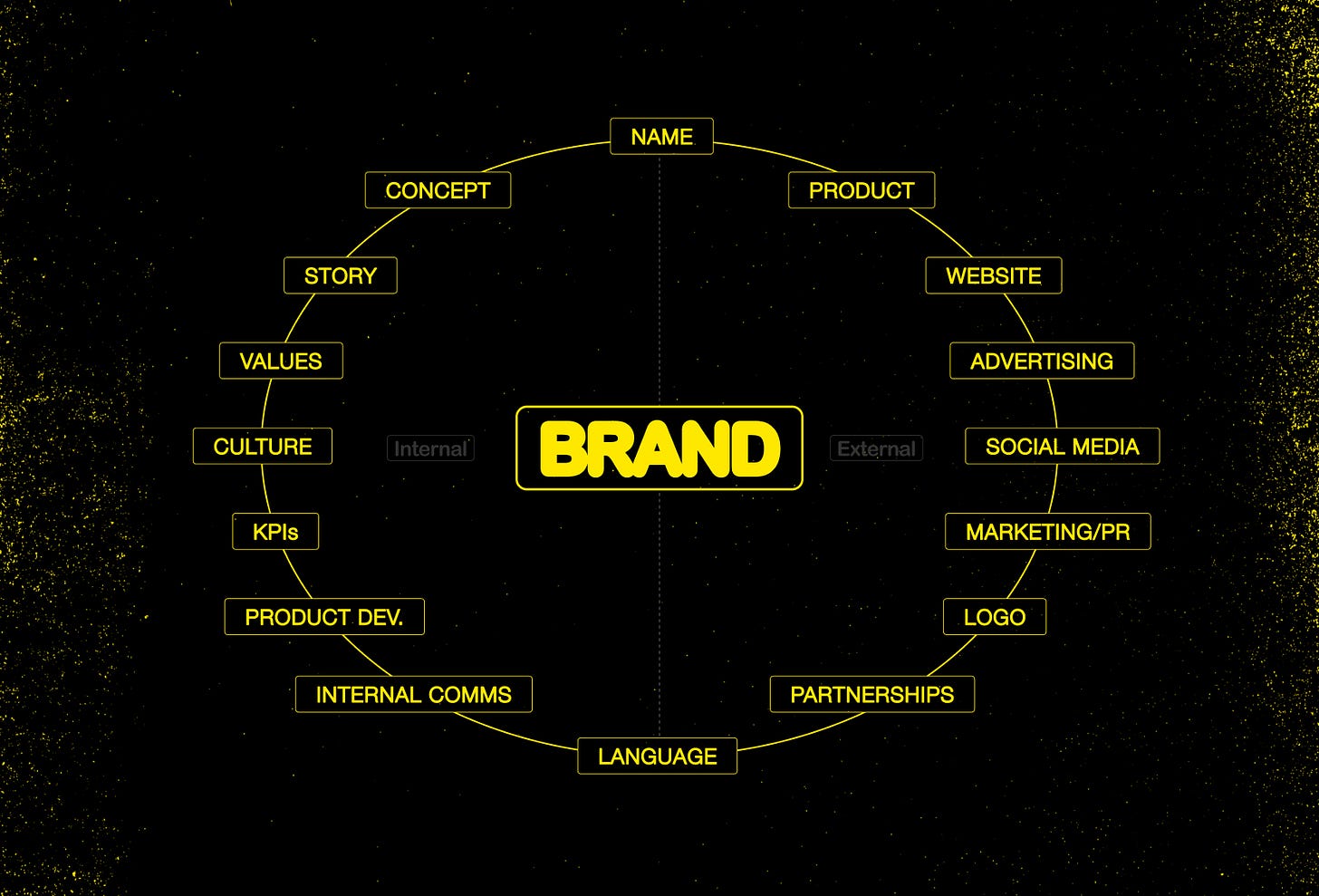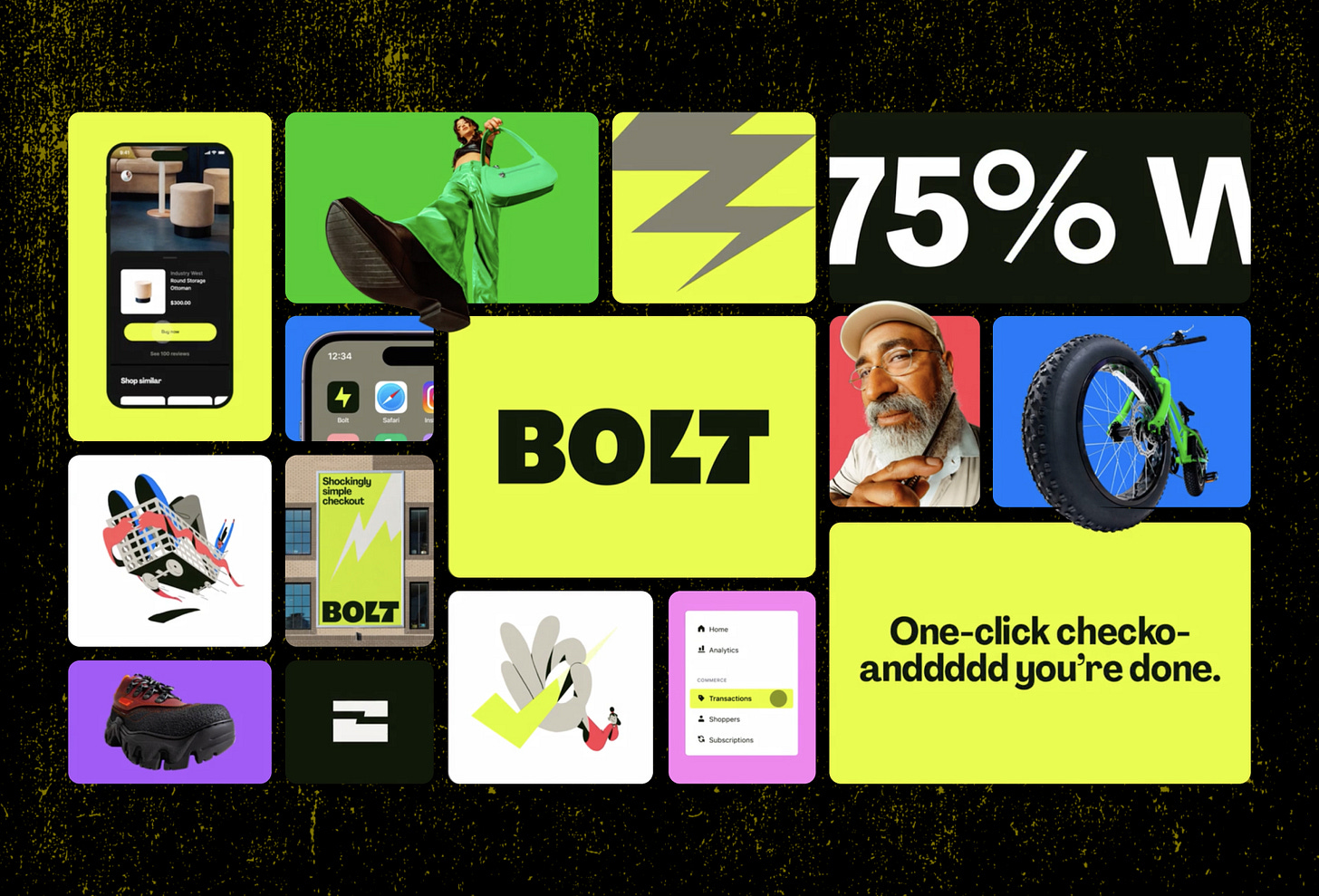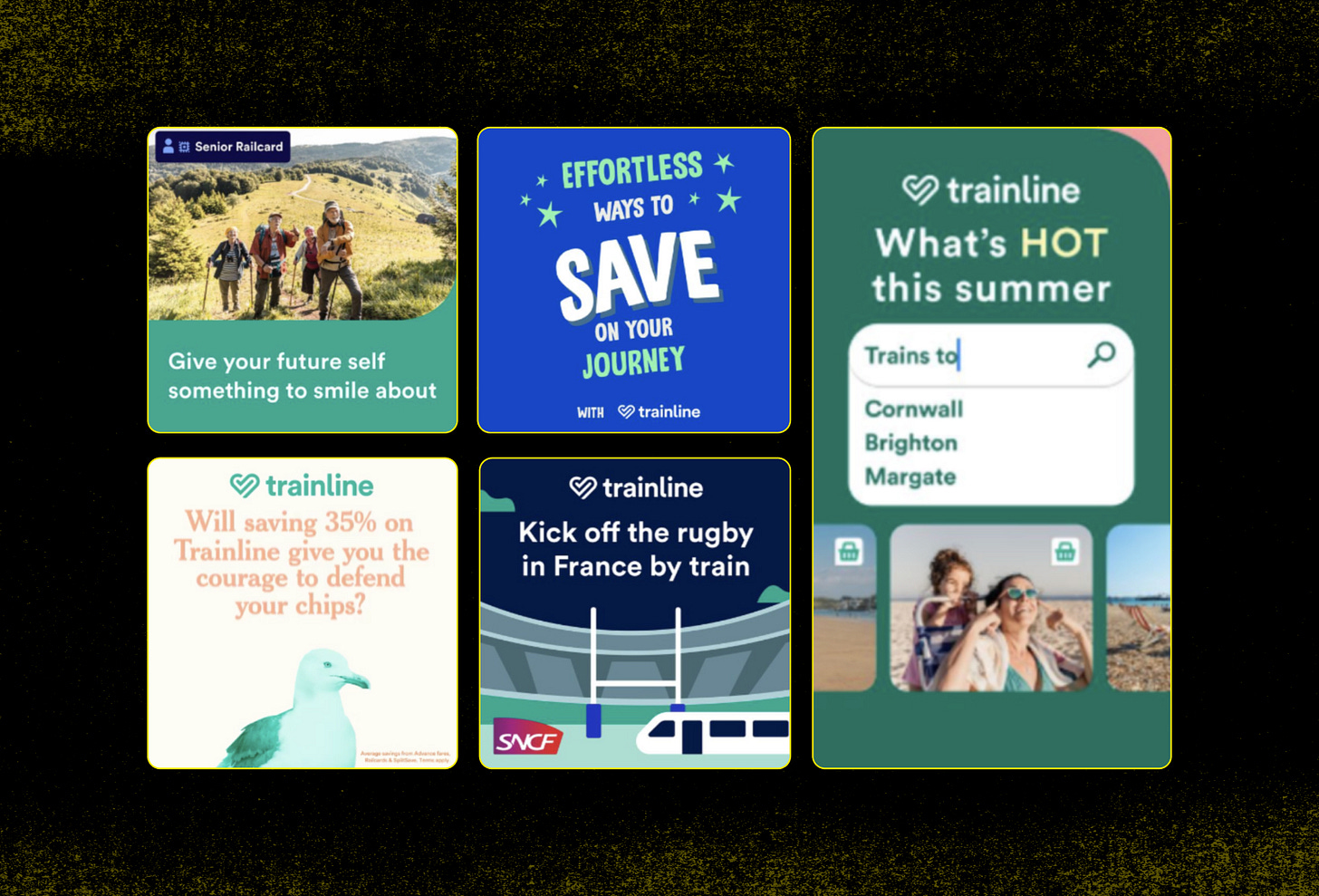Why brand consistency can make or break your brand
You’ve just opened an email about brand consistency. This probably means that you’re interested in some of the meaty topics of brand building and that’s exactly why we’ve started this newsletter.
Welcome to OFF Brand – a newsletter from Koto. In each issue we’ll deal with a branding topic you’ll normally find us talking about with our clients and peers.
Our goal is to share the latest and greatest thinking (not just our own) on a range of critical subjects. We want this to become a trusted voice for marketing operators and brand enthusiasts alike. Think practical tips, actionable insights, useful frameworks, topical examples – all so you can take your brand to new heights.
Crazily, 2.5K people signed up to this newsletter before we even published an issue. If someone sent you this post and you’re not subscribed, join those people learning how to build and scale better brands. And one final thing before we start, a big thanks to the friendly folks at Adyen, hims & hers, and Insight Timer for their contributions to this edition – and everyone at Koto who had something to say on the matter.
What you’ll learn about brand consistency
What it is
Attitudes towards it
Why it’s difficult
Why it matters
How to achieve it
Good examples
Bad examples
Tips, tools and frameworks for consistency
What is brand consistency?
Let’s begin by unpicking the jargon a little…
The brand and marketing space is awash with terms and phrases that are simultaneously profound and meaningless, so stopping to reflect on what they mean can be a very helpful starting point. By ‘brand consistency’, we simply mean ‘the act of replicating or repeating actions and behaviors without deviation’.
Sounds boring, but like most things done well, it’s far from boring. In fact, it’s the secret ingredient that distinguishes successful brands from the rest. Maintaining consistency in all areas of your brand experience is crucial in capturing attention, emotional connection, fostering loyalty – the whole notion of ‘building a brand’ is predicated on consistency.
A relationship between a brand and its audience is no different from personal relationships. It pushes the same triggers and needs the same care and attention. We want consistency from the people in our life to trust them; brands are no different. This doesn’t mean brands can’t change and evolve, but any change should be considered carefully. That's where creativity comes in.
What are the attitudes towards consistency?
The truth is, agencies tend to have a fickle relationship with consistency. There’s rarely a ‘let’s see how much of the old identity we can keep’ discussion in branding agencies. And advertising agencies are often focused on making lovely shiny campaigns over brand building, typically with one eye on some awards.
On a human level, this might be because the people who work in agencies have a strong, instinctive desire to create change. Change is also on the menu because it’s mandated in the briefs they receive – brand and marketing teams express a desire for change and agencies are very happy to oblige. There are few, if any, examples we can think of where the answer to a branding brief was: don’t deviate, repeat what you’re currently doing.
On a client side, lots of brand and product teams have probably joined companies to evolve, change and challenge the brand. And at the core, this is right. Brands are not static things, they should be evolving to survive, to keep pace with innovation and competition.
So against this desire for change on both sides of the brand management spectrum, the key thing to do is acknowledge the need for consistency and to plan where and how that happens. It needs to be in your conversations daily and on your list of goals. And in this lays the big challenge, because brand consistency is notoriously hard.
Why is consistency hard to achieve?
According to this study, roughly one third of US B2B marketing and sales professionals say that they struggle to implement brand identity consistently.
The top reasons for this struggle were listed as:
1. They cannot ensure standards
2. There are no uniform guidelines
3. Brand importance is undervalued
Sometimes the search for consistency is seen as a brake on progress – the sort that modern tech companies are so keen to eradicate. Aaron Poe, hims & hers’ new VP Brand Design explains:
"At Zapier (Aaron’s former company NDLR), we’re a company that values a 'default to action' mindset, and often that means someone from a different department will make something that is not on-brand per se, and ship it. We're aiming to educate the entire org about the value of brand consistency and ask themselves if they should run it by the brand studio before shipping – or at the very least – they should feel empowered to review the brand guidelines to make that judgment call."
Aaron’s point about having to educate the whole organization is key. Getting brand consistency right is tough, as it's not just about your marketing channels. It covers everything across your company – from your business purpose and mission to your culture, values and products. There’s also a slew of external factors like customer comments and ratings on Google, Trustpilot etc. Even opinion leaders, influencers, and journalists have a say, especially if you encounter bad PR for any reason.
For many companies there’s also the challenge of having to keep up with bigger and better funded competitors. If you’ve worked in branding for more than two minutes then you would have heard someone reference Apple. Everybody respects Apple and the brand they have built, and rightly so; they are consistent from product to brand to marketing and rarely make a misstep. But with a massive workforce across those departments – and the budgets to match – you would hope so.
So, we know it’s not on everyone’s minds and that it’s hard. How do we get consistency onto the roadmap? Well, the start is being able to make a compelling case for it with all stakeholders.
Why does consistency matter?
By now, the argument for consistency might seem so obvious that it doesn’t don’t need spelling out again, but we will anyway:
Brands are results, established in the mind, built over time. Repeated actions create strong patterns and people’s minds like patterns. The clearer the pattern, the more identifiable the brand.
This is true for anything that can be a brand, from a FMCG product to SaaS software. Consistency therefore is one of – if not the most – powerful levers for brand building. (Take that, storytelling).
According to Shutterstock, 60% of marketers create a minimum of one piece of content each day. Having a well-defined and repeatable way of making things – from social posts to performance marketing assets – can save an enormous amount of time and effort operationally. This statistic is also a contributing factor to why consistency is so hard to achieve. If you’re pushing 300 pieces of content a year then that’s a lot of consistency to consider and probably a lot of people and things to manage.
Thinking beyond the practical benefits, there’s also a confidence that comes with consistency. The Airbnb brand has been consistently centered around ‘belonging’ since 2014. The singular focus on this idea helps the business to know how to react in uncertain times - evidenced by the way they can respond quickly to events like a recession or humanitarian disasters in ways that feel authentic, distinctive and not overtly opportunistic. They know who they are and are metronomic in their consistency, allowing them to manage the large output of marketing materials they publish across all their channels. This confidence allows them to be quite simple in their overarching visual approach, boosting consistency even more.
When does consistency become pointless?
There is absolutely no use in being consistent if the result isn’t beneficial to your business. What’s the point of everything being consistent if all it achieves is a perfect corporate camouflage that makes your brand impossible to notice among your competitors? Or if your consistent approach to branding results in an identity that feels outdated or lacking in imagination? The big questions we’d encourage everyone at the wheel of a brand to grapple with are:
What are you consistent with?
Why are you consistent with it?
How are you consistent with it?
A good recent example of misplaced consistency is Corporate Memphis, a heavily used illustration style widely popularised when Facebook introduced Alegria, an illustration system commissioned from design agency Buck and illustrator Xoana Herrera in 2017. Flexible, attractive and easy to use, it spread from Facebook to many tech companies and still dominates through its ease of application.
Remember: it’s easy to look consistent to the category you’re in, but it’s often far more effective not to.
What does consistency look like in action?
Brand consistency has many dimensions. You can be consistent with your visual assets, tone of voice, philosophy, your product or service experience. Ideally, you’ll be consistent with all of these things at once. That’s when the magic really happens; that’s the route to successful brand building: implicitly and explicitly conveying a feeling or message on every possible surface your brand touches.
Melissa Rosenthal, Chief Marketing Officer at Insight Timer, helpfully shed some light on the intent that informs the brand execution of ClickUp, her former company:
“We often use the analogy of ClickUp being your most productive best friend. Just like a trusted companion, we empower you to unlock your efficiency and effectiveness while injecting joy and humor into the entire process. We ensure that this ethos permeates every aspect of our brand, creating a cohesive and engaging experience for our users.”
Notice how this isn’t prescriptive visually, but in intent - efficient, effective, joyful, humorous - the four key notes in the tune that brand is playing.
We’re going to self-indulgently use our work with Bolt to unpack consistency in action. It starts with our strategic brand idea: Own speed. The product: one-click checkout. The main benefit: speed. The idea was there already, we just needed to execute. So it’s in the name. There’s a lightning bolt in the logo. An electric color that feels fast. Motion principles that convey urgency. Art direction that suggests movement. Messaging that accelerates. Every individual element of the brand identity is consistently reinforcing the associations Bolt wants to own. It sounds easy, but it can only be done if you’re completely clear on exactly what it is you want to own.
Does consistency matter in some categories more than others?
You’d probably become a little unsettled if the bank you rely on changed its aesthetic language and tone every season. Equally, demand for a fashion brand that clings on to old trends for too long is likely to decline. Consumers have different expectations and considerations from brands in different categories, therefore brand identities need to be built to reflect the specific demands of the category. Consistency always matters – understanding what you’re consistent with or about is the key.
We’re fans of Buck’s campaign work for Zapier for this exact reason. What on the surface might seem counterintuitive – introducing a variety of clashing art direction styles into a single campaign – is actually tactically astute. The illustration becomes the eye-catching element, its job to round up the eyeballs and convey an abstract message, whilst the core Zapier brand identity, logo, typography, tone, color and geometry is there to bring the brand to the party. Flexibility within a consistent framework. Nice. It’s not just an isolated campaign aesthetic either – they have consistent use of assets across the web journey too.
Consistently inconsistent
Contrast that Zapier work with these recent Trainline ads. There are two versions of the brand in the market at one time, meaning that customers, both existing and potential, aren't likely to connect the dots. In the long run, playing fast and loose with a brand’s assets or identity in a marketing context is harmful for the brand. It creates a gap between the product/service experience and the marketing; dissonance that goes against the compounding, pattern-creation benefits of consistency we talked about earlier. You have to constantly reintroduce yourself, which many brands miss in their dash to create novelty advertising (which, by the way, usually has a character at the center of it).
It’s worth pointing out that Trainline has been a client of ours – we designed the logo and much of the most recent brand worlds – so we’re very much invested in seeing the brand flourish.
What’s a good framework for consistency?
The best way to assess your brand consistency is from a user perspective. After all, that’s the only perspective that really matters. So, go on that journey yourself and document every single interaction you have, things you see, surfaces you touch. Lay it all out, take a few steps back and put a critical pair of specs on. Then, work through these three sections.
Strategic consistency
How aligned is the intent, idea or concept behind the brand?
The best brand identities are held together by a singular concept. Is yours?
Does your strategic intent have the correct approach? One that will help you achieve your business goals? If the answer is anything less than a resounding yes, then this is where your journey with consistency needs to start.
Visual consistency
Take a closer look at the visual assets you’re using and the relationships used to apply them. Everything from your logo to typography, icons to color, motion principles to use of materials. All of these things say something about your brand. Are they all saying the same thing?
Have you got things present in your brand which are the result of legacy or internal disagreement that are causing tension?
Look across the customer journey from marketing into product. How joined up or systematic are you in the way you use or apply these assets? Are the assets fit for purpose? Does the application of the assets need work?
Do the assets work in all your channels? Too many brands try to squeeze big marketing ideas into digital channels with little success.
Verbal consistency
This is one area where brands are often guilty of being consistent to their category, rather than their strategy. What are the hallmarks of your brand’s particular verbal identity?
Find examples of messaging on different channels. Do these messages sound like the same person is saying them? How consistent is the tone of voice and style of language?
Are there areas that are more unique and others more generic?
Look beyond just your marketing. What are sales teams using? What’s the customer support experience like?
How is your PR connected? If executives are appearing in the media they should be considering this when talking about the brand.
Your verbal identity is arguably the biggest threat to a consistent brand, as everyone around your company talks about your brand on a daily basis, so keep this top of mind.
Getting a benchmark for how consistent your own brand is in regards to strategy, visual and verbal identity helps you to efficiently identify where to rectify things.
Top tip: Doing the same exercise but for two or three of your competitors will also help you understand category tropes (and inject some urgency into finding a solution).
Bonus round: How do your customers receive you? Is the projection you think you’re making consistent with what they are receiving? This could entail examining client feedback on review platforms and social media, understanding candidate perspectives (even from those who weren't selected), undertaking standalone research or gauging the opinions of journalists, and even considering the viewpoints of your competitors.
The answer is guidelines, right?
Sort of. Gone are the days of massive PDF rulebooks though (well, they should be gone). For today’s brand leaders, digital templates, best-in-class-examples and open, accessible brand assets are critical in enabling consistency across the entire organization. Here’s Jeroen de Lange, VP of Creative at Adyen:
“We approach everything digital-first. By doing this, every team has access to the brand truth. And we create brand libraries in Figma which we maintain.”
Success also comes through thinking about who needs what. Know your audiences. Sales teams are unlikely to be nerding off on the ins and outs of the custom typeface you’ve spent three months crafting.
If we go back to some of the long-term golden children of brand consistency – businesses like Apple or Airbnb – then you realize that company culture is probably the most powerful tool at your disposal. So: search for ways for your people to embody the brand, to do seemingly small things in a brand-centric way, share regular, implicit and explicit reminders of what the brand is about. Create a culture of brand and – to some extent – it will manage itself.
What can I do to get started?
First, work out what you’re going to be consistent about – what’s the intent behind your brand?
Do a quick customer journey audit to assess how consistent or inconsistent your brand is currently.
Apply a strategic, visual and verbal lens to this work to assess the biggest areas of improvement and return.
Be disciplined. Brands are built through consistent behavior over time. We know it’s hard work.
Be imaginative. Invest in finding ways to revitalize and represent before starting from scratch.
Create interest around the topic to avoid eyes glazing over.
Create the tools that make consistency possible – but be aware that software, however good it might be, is no replacement for skilled strategists, designers and writers.
Deep-dive further with more reads
To deepen your understanding of the topic and continue your brand consistency journey, we recommend the following classic books:
Building Strong Brands by David A. Aaker
The Brand Gap by Marty Neumeier
Brand Sense: Build Powerful Brands through Touch, Taste, Smell, Sight, and Sound by Martin Lindstrom
Let us know what you think
Hit reply or comment:
What’s your experience of brand consistency?
What have we missed?
What resonated with you the most?
Any suggestions for our next newsletter?
Like any new endeavor, this took slightly longer than planned, so we hope you liked what you read. Make sure to sign up to receive our next issue in your inbox.
See you in a few weeks for the next edition of OFF Brand. Let’s hope it’s consistent.











A very good mail with a lot of relevant content. I starred it
Amazing read! It already can be used as an step-by-step guide towards building consistency
May I ask you a question about one part?
When you talk about Zapier, what exactly makes it consistent? For me, all the images look different: the ones on blue background have a different font, and the last two have different styles of illustrations. And I don‘t understand how the blue matches with that green, it feels like they have different moods.